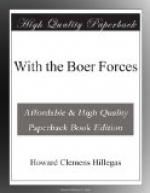In one of the days’ fighting at Magersfontein a number of youthful Boers, who were in their first battle, allowed about one hundred Highlanders to approach to within a hundred yards of the trench in which they were concealed, and then sprang up and shouted: “Hands up!” The Highlanders were completely surprised, promptly threw down their arms, and advanced with arms above their heads. One of the young Boers approached them, then called his friends, and, scratching his head, asked: “What shall we do with them?” There was a brief consultation, and it was decided to allow the Highlanders to return to their column. When the young burghers arrived at the Boer laager with the captured rifles and bandoliers, General Cronje asked them why they did not bring the men. The youths looked at each other for a while; then one replied, rather sheepishly, “We did not know they were wanted.” In the same battle an old Boer had his first view of the quaintly dressed Highlanders, and at a distance mistook them for a herd of ostriches from a farm that was known to be in the neighbourhood, refused to fire upon them, and persuaded all the burghers in his and the neighbouring trenches that they were ostriches and not human beings.
During the second battle at Colenso a large number of Boers swam across the river and captured thirty or forty British soldiers who had lost the way and had taken refuge in a sluit. An old takhaar among the Boers had discarded almost all his clothing before entering the river, and was an amusing spectacle in shirt, bandolier, and rifle. One of the soldiers went up to the takhaar, looked at him from head to foot, and, after saluting most servilely, inquired, “To what regiment do you belong, sir?” The Boer returned the salute, and, without smiling, replied, “I am one of Rhodes’ ‘uncivilised Boers,’ sir.” In the same fight an ammunition waggon, heavily laden, and covered with a huge piece of duck, was in an exposed position, and attracted the fire of the British artillery. General Meyer and a number of burghers were near the waggon, and were waiting for a lull in the bombardment in order to take the vehicle to a place of safety. They counted thirty-five shells that fell around the waggon without striking it, and then the firing ceased. Several men were sent forward to move the vehicle, and when they were within several yards of it two Kafirs crept from under the duck covering, shook themselves, and walked away as if nothing had interrupted their sleep.
In the Pretoria commando there was a young professional photographer named Reginald Shepperd who carried his camera and apparatus with him during the greater part of the campaign, and took photographs whenever he had an opportunity. On the morning of the Spion Kop fight, when the burghers were preparing to make the attack on the enemy, Mr. Shepperd gathered all the burghers of the Carolina laager and posed them for a photograph. He was on the point of exposing




